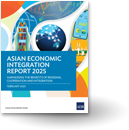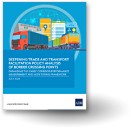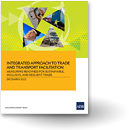Spotlight Archives
- New ILO-ADB Report--ASEAN Community 2015: Managing Integration for Better Jobs and Shared Prosperity19 Aug 2014The report ASEAN Community 2015: Managing Integration for Better Jobs and Shared Prosperity examines the impact of the ASEAN Economic Community (AEC) on labor markets using economic model simulations. It highlights the challenges and opportunities that will accompany the AEC, including managing labor migration, boosting productivity and wages, improving job quality, and supporting the required structural changes and regional cooperation. The report also offers policy recommendations for creating better jobs and ensuring that the benefits of the AEC are equitably shared. Read more.
- RCI Chat August 2014August 2014ARIC releases August 2014 issue of its monthly newsletter, RCI Chat. It tracks regional cooperation and integration news in Asia focusing on cross-border infrastructure, trade and investment, money and finance, and regional public goods. This issue includes a feature on CAREC program's Senior Officials Meeting highlights. Subscribe.
- FTA database update: Asian FTAs now total 278; 119 in effectJuly 2014Free trade agreements (FTAs) in Asia and the Pacific continue to grow rapidly. With only 55 FTAs in 2000, there are now 278 FTAs in various stages of development as of July 2014. Of these FTAs, 119 are in force while the rest are either proposed, under negotiation, or signed. Go to FTA database.
- RCI Chat July 2014Jul 2014ARIC releases the maiden issue of its monthly newsletter, RCI Chat. It tracks regional cooperation and integration news in Asia focusing on cross-border infrastructure, trade and investment, money and finance, and regional public goods. This issue includes a feature on the SASEC program. Subscribe.
- Assessing Impact of Regional Integration on Productivity and Income Inequality, 4 July (2:00-3:30 Manila time), ADB HeadquartersJul 2014David Roland-Holst, professor, University of California at Berkeley is speaking on RCI's potential to promote more sustained and inclusive growth in Asia and the Pacific, including the role of policies at the national and regional levels. See program.
- Pacific Economic Monitor - Midyear Review, July 20141 July 2014This issue updates the 2014 and 2015 GDP growth and inflation projections for ADB's Pacific developing member countries - from those presented earlier in Asian Development Outlook 2014 - and explores the Pacific region’s job creation challenges. Read more.
- ADB Working Paper Series on Regional Economic Integration No. 135 - Has Regional Integration Led to Greater Risk-sharing in Asia?July 2014With the ongoing financial development and integration in Asia, it is important to ensure that the benefits of integration outweigh its costs. In this paper, T.H. Ng and D. Yarcia analyzes whether the degree of risk-sharing in East Asia has improved along with the observed rise in integration. Read more.
- ADB Working Paper Series on Regional Economic Integration No. 136 - How Capital Flows Affect Economy-wide Vulnerability and Inequality: Flow-of-Funds Analysis of Selected Asian EconomiesJuly 2014Using flow-of-funds data, I. Azis and D. Yarcia determines that the surge in liquidity in Asian financial systems has changed the behavior of agents and institutions. Read more.
- Infographics: ARIC in NumbersJun 2014ADB OREI's Asia Regional Integration Center (ARIC) releases an infographic of its milestones and achievements in creating and disseminating RCI-related knowledge products, as well as providing support to regional dialogue, from its inception in 1999 to date.
- New ARIC-RSDD Climate Change Strategies Database now available17 June 2014Visit the new Climate Change Strategies Database—a joint project of ARIC and ADB's Regional and Sustainable Development Department (RSDD)—to find the most updated and comprehensive summary of climate change strategies in Asia and the Pacific. Learn about its special features such as customized query builder and quick download of Excel data. Watch the instructional video.




